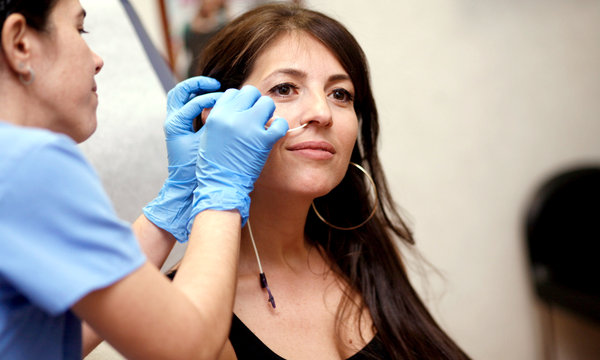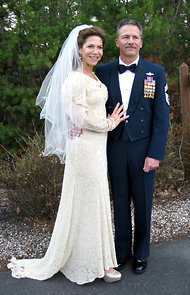All brides have anxiety about looking great on the big day. The women featured a recent New York Times article about losing weight for one’s wedding who went on diets varying from fasts to calorie restricted fluid diets administered by tubes down the nose are, in my eyes, misguided.
My husband and I moved faster than the average – we got engaged in May and married in October. Still, I knew what needed to be done and got my butt back to Weight Watchers and on a work-out schedule with a qualified personal trainer (to be fair, there is one woman in the article who hit the gym).
They say “all things in moderation” in terms of dieting, and we say it definitely applies in terms of wedding prep. Like planning isn’t stressful enough without a tube up your nose? What do you think? Weigh in in our comments section. My favorite reaction so far is from my mom, who sent me the article: “Yech.” Thanks for the tip Mom!
Losing Weight in Time for the Wedding

Jessica Schnaider, 41, spent eight days on a feeding tube, a process that costs $1,500 for 10 days, so she would fit into her wedding gown when she marries in Argentina in June. She had the tube removed early because she was losing too much weight.
By LINDA LEE
Published: April 13, 2012
JENNIFER DERRICK’S weight had crept to 159 pounds from 125, and she knew she would not fit into her grandmother’s wedding dress
Barbara Fernandez for The New York Times
In March, Jessica Schnaider, 41, of Surfside, Fla., was preparing to shop for a wedding gown by spending eight days on a feeding tube. The diet, under a doctor’s supervision, offered 800 calories a day while she went about her business, with a tube in her nose.
A 2007 Cornell University study by Lori Neighbors and Jeffery Sobal found that 70 percent of 272 engaged women said they wanted to lose weight, typically 20 pounds. So brides are increasingly going on crash diets, inspired by seeing celebrities like Sarah Jessica Parker or Gwyneth Paltrow, cowed by the prospect of wearing a revealing and expensive gown and knowing that wedding photos (if not the marriage) are forever.
In the two months of fittings before most clients’ weddings at Kleinfeld Bridal in New York, seamstresses are kept busy taking in gowns. Brides-to-be say, “I don’t want the size 16, I want the 14 or the 12,’ ” said Jennette Kruszka, Kleinfeld’s marketing director. (Note: wedding dresses run small, so a typical size 8 dress will be a size 10 or 12, a psychological shock for the young woman buying the gown. Kleinfeld resists brides who want smaller sizes, because taking a dress in is easier than letting it out.)
“There was no way I could imagine seeing myself in a strapless bridal gown,” said Colleen McGowan, 36, a New Yorker who used Weight Watchers and hired a personal trainer to drop 20 pounds for her wedding nine years ago. Her trainer, Sue Fleming, a fitness coach in Brooklyn, is the author of the book “Buff Brides.”
“I’ve been training brides for 12 to 13 years, and the typical weight loss is 15 to 20 pounds,” said Ms. Fleming, who charges $140 to $200 a session. One of her customers was so proud of her improved arms that she dropped and did push-ups before walking the aisle.
Brooke Baxter, 34, a music entrepreneur in Brooklyn who got engaged in November, ordered the BluePrintCleanse, which costs $65 a day for six bottles of organic juice. It helped her drop six pounds in three days. She will cleanse again before her wedding in May, she said.
BluePrint actively courts brides, even suggesting on its Web site “a cleanse with your whole bridal party.” Erica Huss, a founder of BluePrint, explained the effect of the diet as “You’re working out all the bad stuff.” Put another way, an all-juice diet is a laxative.
But the many “detoxing” cleanses make misleading claims, says Dr. David Gorski, an associate professor of surgery at Wayne State University in Detroit and a blogger at Science-Based Medicine. “Do you notice they never tell you what the toxins actually are?” he said. “There’s no science to back them up.”
Fad diets are cyclical. Master Cleanse (lemon juice, paprika, a dash of maple syrup, all in water, for 10 days) was published in a 1976 book and returned to popular consciousness with Ashton Kutcher and Demi Moore two years ago.
“Celebrities are not known for doing things that are necessarily the healthiest or most sensible in many parts of their lives,” said Dr. Louis Aronne, the director of the Comprehensive Weight Control Program at NewYork-Presbyterian/Weill Cornell Medical Center. “Nutrition should probably be included in that.”
The Atkins diet inspired the South Beach diet, which, most recently, has been popular as the high-protein, low-fat Dukan diet. “I didn’t want to be a fat bride,” said Casey Crisefi, 31, of Hagerstown, Pa., who lost 70 pounds on Dukan.
One of the most drastic diets involves daily injections of human chorionic gonadotropin, a hormone associated with pregnancy. The method was popularized in 1954 when Dr. Albert T. W. Simeons published “Pounds and Inches.” The fad is back, and in December 2010, the Food and Drug Administration reiterated its findings: over-the-counter human chorionic gonadotropin was fraudulent for weight loss and illegal, and a prescription for it does not help weight loss.
Dr. Cynthia Macer of the MediLean clinic in Rolling Hills Estates, Calif., says she tells her patients “flat out what the F.D.A says.” But they lose weight by combining the injections, weekly meetings with a registered nurse and a 500-calorie diet. The $950 cost includes medical screening, the hormone and instructions in self-administering the shots.
Lindsay Gardner, 28, lost 14 pounds on the diet in six weeks before her wedding last year, but critics insist the injections are a placebo.
Something medical is indeed happening in the newest diet to reach the United States. Dr. Oliver R. Di Pietro has been offering what he calls a K-E diet at his modest clinic in Bay Harbor Islands, Fla., since last July.
Jennifer and Robert Derrick on their wedding day in March.
Related
“I get a lot of brides,” Dr. Di Pietro said. “Nervous eating.”
It uses a nasogastric tube (a tube that goes through the nose and down the esophagus into the stomach) to provide all nourishment, with no carbohydrates, for 10 days. Dr. Di Pietro said body weight is lost quickly through ketosis, the state in which the body burns fat rather than sugar. Patients at his office are monitored during the 10-day period for things like constipation, bad breath and dizziness.
“Any extreme low-calorie diet is associated with side effects, kidney stones, dehydration, headaches,” Dr. Aronne said, “and if you lose muscle mass and water, what’s the point of that?”
While the tube diet is fairly unknown in this country, it has been popular for years in Italy and Spain, where it is used casually to lose weight before a big event, as well as for more significant weight loss. In England, where it has been offered for the past year as the KEN (or ketogenic enteral nutrition) diet, The Daily Mail asked if it was “the most extreme diet ever,” before adding that a National Health Service doctor was offering it.
Dr. Scott Shikora, the director of the Center for Metabolic Health and Bariatric Surgery at Brigham and Women’s Hospital in Boston, said: “Putting a tube in one’s nose, it’s not always comfortable and pleasant. And this has to be medically supervised.”
Ms. Schnaider had the tube removed early, not because of discomfort, but because she was losing too much weight, reaching 127 pounds, 10 pounds down, in eight days. Her wedding is scheduled for June in her native Argentina.
“At first I decided not to do it for people who just want to lose a few pounds,” Dr. Di Pietro said. “But then I thought, why should I say 5 or 10 pounds are not enough? People want to be perfect.”
They are willing to pay for it: $1,500 for the 10 days, which includes a screening and the equipment. They also have to feel confident enough to wear the tube in public.
“People think I’m sick, I’m dying,” said Ms. Schnaider, a watch wholesaler in Miami. She refrained from going into her daughters’ school. “The children, they would be scared,” she said.
Dr. Shikora said any caloric restriction will lead to weight loss. “The novelty is, they shove a tube in your nose,” he said.
“It doesn’t matter if it’s through a tube, a straw, a meal plan,” he said. “They all work, if someone goes from 3,000 calories a day to 800.”
The problem, critics of these programs say, is crash dieting in general.
“I don’t want to tell a bride she shouldn’t look good for the wedding,” Dr. Aronne said. “But we tell them, ‘You can get to the same place if you started earlier, instead of waiting until the last minute and doing something drastic.’ ”





